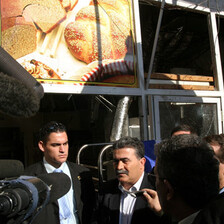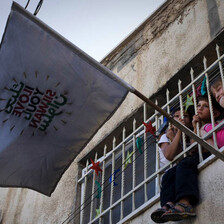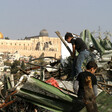Silwan, East Jerusalem 5 April 2010
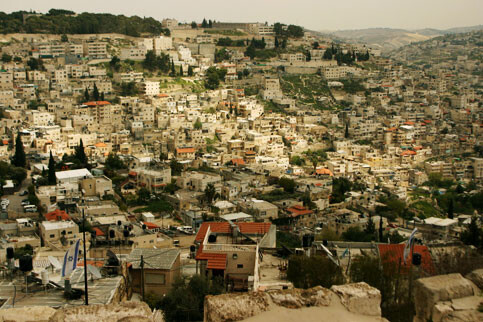
The Silwan neighborhood seen from the Old City of Jerusalem. (Mimmi Nietula/MaanImages)
Sometimes when I walk in Wadi Hilweh, Jerusalem’s beautiful valley, I imagine Hilweh, the legendary Palestinian grandmother for whom this valley is named, treading up the main road in the year 1947 on the way back from her olive grove with a heavy wicker basket perched on her head. If you listened carefully, you could hear her cursing her bad knees. The next scene is Hilweh sprawled on the ground, blood and olives streaming down the valley. The bullet that had pierced her heart made its way from the rifle of a young sniper from one of the Zionist militias. Real events, legends, rumors and beliefs, seasoned with national ethos and zeitgeist, all are kneaded together to create the tales that we hear today. In the end, I tell myself that what I don’t see, I don’t know. Still today, Wadi Hilweh holds many secrets in its air, trees and stones, but mostly, beneath the ground.
Photographs, drawings and written accounts tell us that many years ago, the valley, part of the village of Silwan, was renowned for its perennial gushing spring, the graceful overhanging cacti, the syrupy quality of its figs, and the delicacy of its olives. Countless pilgrims, travelers and merchants have passed through the valley, as it is located just outside Jerusalem’s Old City, and is the closest human settlement to the al-Aqsa Mosque and the Haram al-Sharif or the Temple Mount. Consequently, the valley served as one of the final refreshment stations, where worn travelers from Bethlehem in the south washed their dusty feet and enjoyed a cold beverage, before arriving in the holiest of halls. In the 62 years since 1948, the beautiful valley has transformed into one of the most densely-populated areas in East Jerusalem, with poor infrastructure and garbage overflowing into the streets, but all this might soon change.
While the world’s eyes are riveted to the diplomatic arguments over Israel’s settlement facts on the ground, Israel is covertly tightening its grip on Wadi Hilweh and al-Bustan neighborhoods in Silwan in a literally underground fashion. Mega-funded by settler organizations and fully backed by the Israeli government and the Jerusalem municipality, the Israel Antiquity Authority is conducting excavations in tunnels under the neighborhood’s houses and lands. The Authority did not initially inform the residents, nor did it seek their consent. Apart from being ethically wrong according to international archaeological standards and academically challenged worldwide, these excavations pose an immediate threat to the residents’ present safety and future existence, and contribute immensely to the overall instability of the area.
Two years ago, locals felt tiny and oddly-timed earthquakes beneath their feet. Some thought they were losing their sanity because of the voices echoing from under the floors. Cracks appeared in sturdy walls, and droplets that made their way through fractures in ceilings spattered on children in their sleep. This led to the discovery of the clandestine underground operation. A lengthy legal struggle ended with the Israeli high court approving the continuation of the excavation work, ruling that history is important to unearth and that no proof was presented to the court as to the relation between the excavations and the damage to the houses in question. Ever since that decision, many new cavities have opened in the street, some several meters deep, and only by luck or divine intervention, no child has yet to fall and be injured.
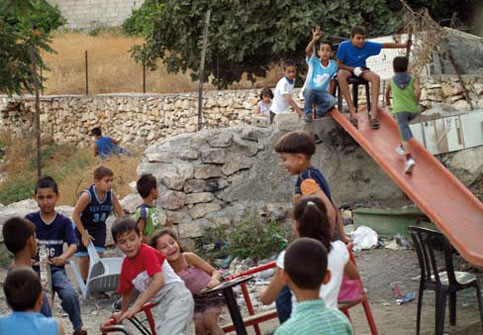
Children playing in Wadi Hilweh (Danny Felsteiner)
The Palestinian children that I teach in the Madaa Silwan Creative Center in Wadi Hilweh have learned to express their predicament in a straightforward way: “The Jews want us to fall.” “I’m a Jew and I don’t want you to fall,” I reply. Then they smile, embarrassed, tell me that I’m different or a “good Jew” or in some awkward magic moments, that they love me, and we continue in our music lesson. Although I appreciate their reassurance of my distinction from the rest of the Jews who want them to fall, I can’t tell them that they are wrong with their simple view of things.
Every child that joyfully comes to the center to do music, art, theater or dance, carries a dark personal story that reflects some part of the overall situation here. Fatme just learned to depict realistic shadings in the art lessons, so she draws her house because it has a demolition order against it and she would like to remember how it looked like before it gets knocked down by “the Jews.” Waseem does really bad in school — he can’t study at home because “the Jews” excavate all day long and use noisy machines that disturb his concentration. Mahdi’s room, which he shares with his four siblings, has become a freezing pool because of the recent cracks in the ceiling caused by the diggings of “the Jews.” These children are not anti-Semitic, they are just paying attention. (In contrast, my childhood in Haifa did not involve “the Muslims” undermining my house, only cleaning the stairway.) When a major hole opened up in the middle of Wadi Hilweh’s main street, all the kids ran out to pose for the photographers. Journalists poured in and asked how it happened and who was responsible. You already know what the kids told them.
The circumstances of that major hole were quite ironic. Several months ago, the Jerusalem municipality decided to start operating the Israeli bus company Egged in Silwan and around the eastern slopes of the Old City. The pretext was the growing number of Jewish settlers, several hundred in total, who moved to live in those areas amidst hundreds of thousands of Palestinians. Presumably, the Jewish settlers had an urgent need for their own familiar Israeli public transportation. The full-size bus, line 43 (numbered perhaps in celebration of the impending 43rd anniversary of the Israeli occupation of East Jerusalem) travels up and down the valley eight times a day. Since Palestinians have their own perfectly efficient East Jerusalem bus company, and settlers make use of their private fancy cars or bullet-proof minibuses, line 43 is almost always empty. It is a tax-money-eating, traffic-jamming, political, useless ghost-bus, and on 2 January 2010, it got stuck in the large hole caused by the underground excavations.
Recently, Madaa Creative Center opened a course in journalism for teenagers and two enrolled. After some investigation, the staff in the center realized that children had either lost faith in journalism or thought it was an inconsequential pastime activity like soccer or lizard hunting. In the last two years every correspondent to every newspaper and channel in the country and abroad has visited Silwan to write or film a very important piece. Everyone was here, but the excavations go on, and the Jerusalem municipality is about to confiscate more land, and Fatma’s neighbors were sent to the street after their house had been demolished, and it seems to the young residents of Silwan that no one really cares.
Ever since the line 43 bus was stuck, more holes and cracks materialized in various locations, popping up like overturned mushrooms after heavy rain. In a recent visit to one of those holes, just above a kindergarten, the municipal engineer was recorded admitting the reason to be the excavations. Media rushed to the scene and the kindergarten children were ushered outside and told to look sad. What awaits these children in reality?
According to municipal and state plans, Wadi Hilweh might soon become verdant and attractive again, as in its glory days. Roads will be closed off to traffic and become lovely promenades, floral bicycle paths will replace dingy alleys, ivy-coated trees will be happily planted in every corner, and extinct biblical birds will be genetically resurrected and forced to nest in strategic tourist locations. Pilgrims with heavy wallets will be heartily welcomed in inns and chain restaurants. They will once again be able to wash their pedicured feet in the spa bubbling waters, and guzzle down cold margaritas with a wonderful view of Jerusalem’s Old City. Line 43 will convert into an open double-decker site-seeing tour bus and will never be empty again!
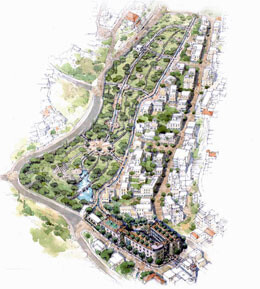
A sketch of the proposed layout for the al-Bustan neighborhood that will replace Palestinian homes.
Today, when I walk in the Wadi Hilweh and al-Bustan neighborhoods I can sadly visualize the biblical touristic paradise that the settlers and the Israeli authorities are planning. They have even shamelessly published a drawing of their vision. On the other hand, it is impossible for me to visualize or grasp the circle of violence and generational hatred that their plans might entail. In a region where the butterfly effect brutally manifests itself on a daily basis, one sniper’s bullet can change the course of history, and Fatme’s drawing of her once-standing home might precede the next horrible bloodshed. The tunnels are being excavated right now, as you are reading this article. What you don’t see, you don’t know? Now you know.
Danny Felsteiner is an Israeli-born musician and writer who lives in Jerusalem. Together with his wife they run a free music school for Palestinian children in Silwan, as part of the Madaa Silwan Creative Center (www.madaasilwan.org). They also travel several times a year to Jordan to give music workshops to Iraqi and Palestinian refugees and to Jordanian children with special needs (www.preludefund.org). He can be reached at dannyfelsteiner A T gmail D O T com.
